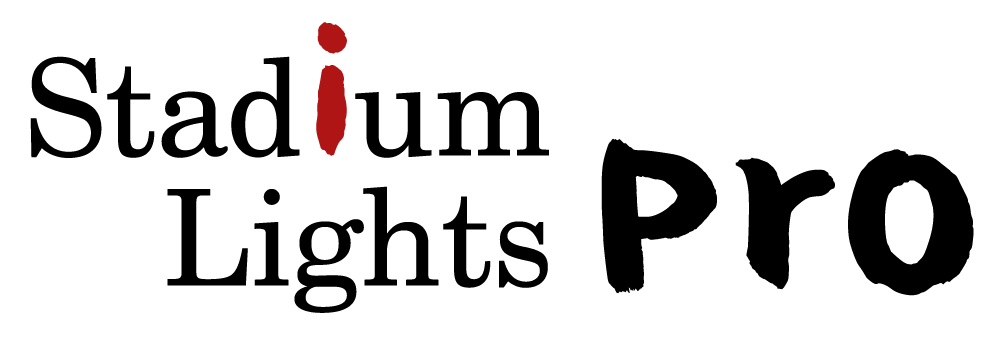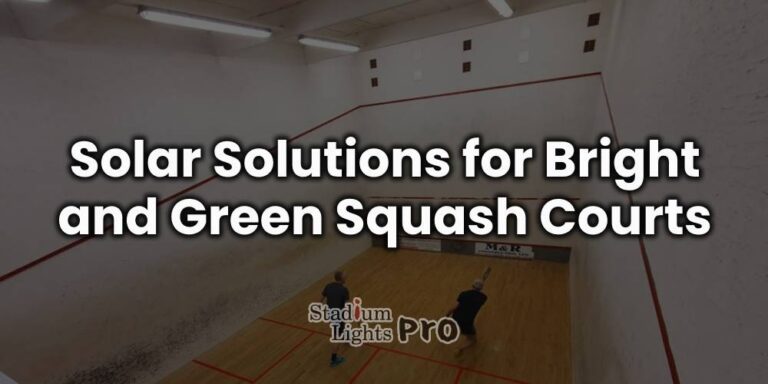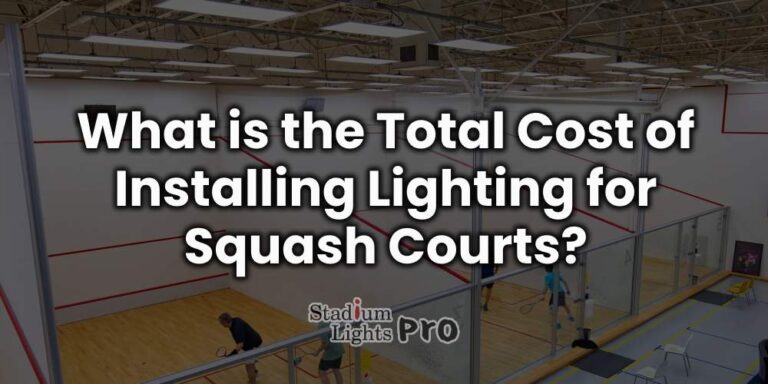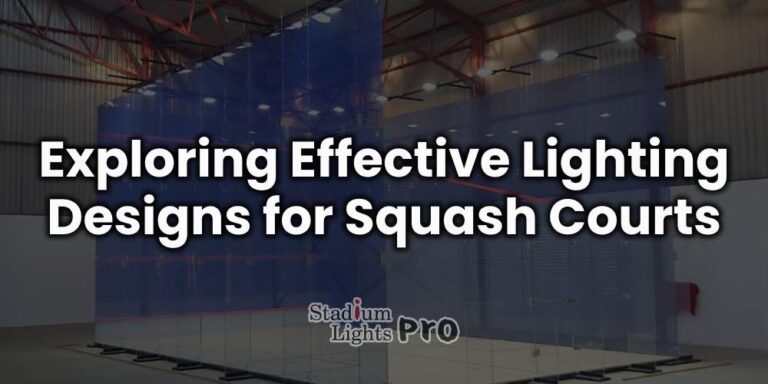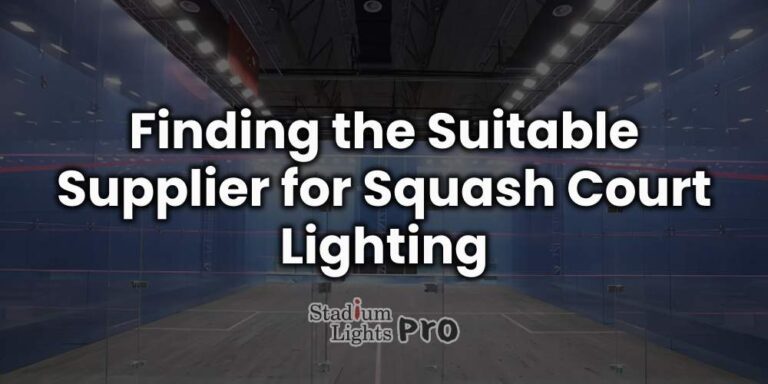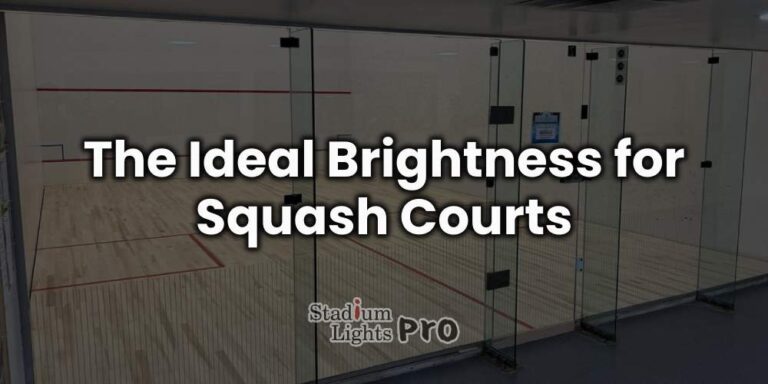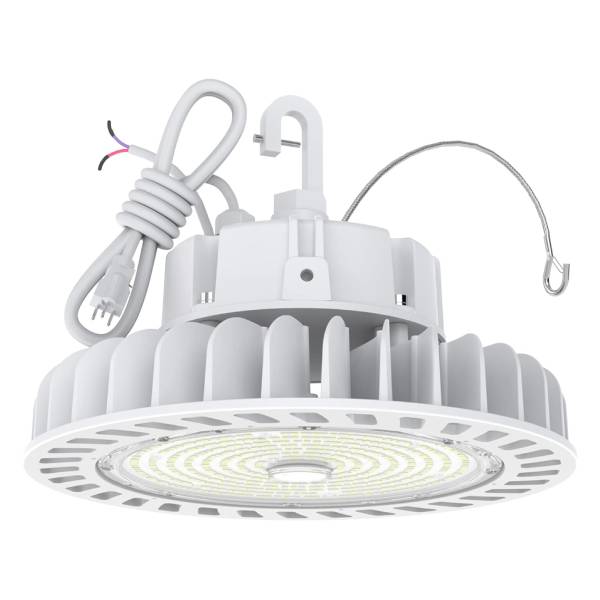
Squash Court Lighting
With the right level of illumination, players can accurately judge the ball’s trajectory, its speed, and anticipate their opponents’ moves, enhancing the competitive edge of the game. Furthermore, proper lighting significantly reduces the risk of accidents by ensuring clear visibility of the court boundaries and potential obstacles, thereby minimizing the chances of collisions or missteps. By investing in top-notch lighting systems that guarantee uniform brightness, minimal glare, and compliance with recommended standards, squash facilities can create an environment that not only fosters peak performance but also prioritizes the safety and well-being of all players.

Our commitment is to provide comprehensive information that addresses all aspects of lighting for squash courts, catering to the needs and inquiries of our customers. Whether it’s understanding the optimal lux levels, the impact of different lighting technologies on player performance, or the cost considerations involved, we aim to cover every aspect that customers may want to know. From the importance of proper illumination for gameplay precision to ensuring safety through glare reduction and uniform brightness, our goal is to empower customers with the knowledge needed to make informed decisions about their squash court lighting solutions.
Contact us for a free lighting consultation
Table of Contents
ToggleThe Functions of Squash Court Lighting
The Game and Its Demands
Squash is a high-speed indoor sport where players rely heavily on their reflexes, precision, and spatial awareness. Given the rapid movement of the ball and players, visibility becomes one of the key factors influencing how the game is played. Lighting doesn’t just brighten a space—it shapes the entire playing experience, impacting visibility, safety, and overall performance. For recreational games, it ensures comfort and playability, while at competitive levels, it must meet the visual demands of professional athletes and officials.
Lighting as Part of Facility Design
A squash court’s architecture—defined by its enclosed walls, reflective surfaces, and compact dimensions—requires a thoughtful lighting design. Every luminaire placement and specification should be compatible with the court’s proportions, wall finishes, and ceiling height. Whether the facility is a standalone court or part of a fitness center, lighting needs to harmonize with the entire design strategy, not stand apart from it.
Standards That Guide Squash Court Lighting
Illuminance Levels Based on Court Usage
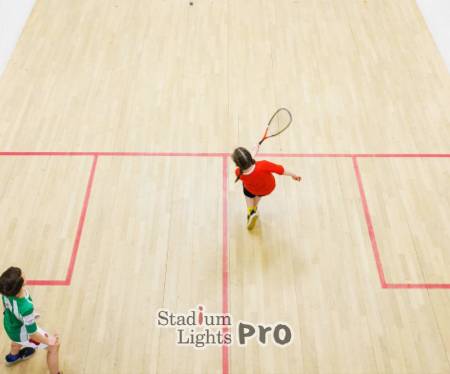 Lighting levels in squash courts are measured in lux, a unit that reflects the amount of visible light falling on a surface. The lux value has a direct impact on the visibility and pace of the game. Squash is a fast-paced sport where the ball moves quickly and players react in milliseconds, so appropriate lighting is a non-negotiable feature for both performance and safety.
Lighting levels in squash courts are measured in lux, a unit that reflects the amount of visible light falling on a surface. The lux value has a direct impact on the visibility and pace of the game. Squash is a fast-paced sport where the ball moves quickly and players react in milliseconds, so appropriate lighting is a non-negotiable feature for both performance and safety.
| Court Type | Recommended Lux | Uniformity (U1 / U2) | Color Temperature (CCT) |
|---|---|---|---|
| Recreational / Training | 300–500 lux | U1 ≥ 0.7 / U2 ≥ 0.8 | 4000K–5000K |
| Competitive / Match Play | 750–1000 lux | U1 ≥ 0.7 / U2 ≥ 0.8 | 4000K–5000K |
| Broadcast / Televised | 1000 lux or higher | U1 ≥ 0.8 / U2 ≥ 0.9 | 4500K–5000K |
Recreational and training courts typically function well with lighting levels around 300 to 500 lux. This range offers a comfortable visual environment for casual play, skill development, and non-competitive practice sessions. It helps players see the ball and walls clearly without being overly bright or harsh.
However, when a court is intended for competitive matches, particularly at professional or televised levels, it demands higher brightness. In these cases, illuminance often needs to be raised to between 750 and 1000 lux. The brighter setting enhances visibility not just for players but also for referees, coaches, and spectators. More importantly, it helps reduce motion blur and improves the audience’s experience when matches are broadcast. High lux levels are essential for capturing the ball’s rapid movement and the players’ agile actions on camera.
Evenness of Light Distribution
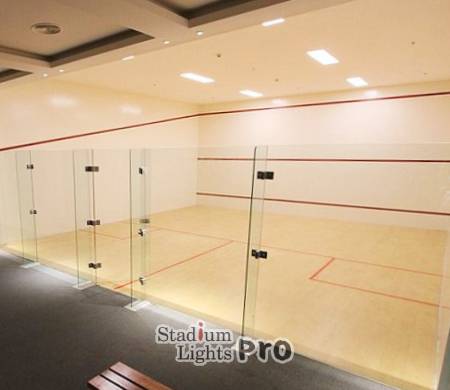 Brightness alone isn’t enough. A squash court must also have uniform lighting across all surfaces, including the playing area and the walls. Uneven lighting can create shadows or bright spots, which distract players and impair depth perception. In a game where players rely heavily on wall rebounds and ball tracking, this can be a serious problem.
Brightness alone isn’t enough. A squash court must also have uniform lighting across all surfaces, including the playing area and the walls. Uneven lighting can create shadows or bright spots, which distract players and impair depth perception. In a game where players rely heavily on wall rebounds and ball tracking, this can be a serious problem.
The evenness of light is assessed using uniformity ratios, specifically U1 and U2. U1 refers to the ratio between the minimum and average illuminance, while U2 compares the minimum to the maximum illuminance. Ideally, a squash court should maintain a U1 of at least 0.7 and a U2 of 0.8 or higher. These benchmarks ensure that the entire playing surface is consistently lit, reducing the chance of visual surprises or errors during high-speed rallies.
Consistent lighting also contributes to a better viewer experience during matches, whether in-person or through a broadcast. Players can anticipate shots more accurately, and spectators can follow the ball without difficulty. A uniformly lit court creates a fair and immersive environment for everyone involved.
Managing Glare and Eye Comfort
Glare is one of the most disruptive lighting problems in squash, especially since players frequently shift their gaze between the floor, walls, and ceiling. Rapid head movements and extreme angles are part of the game, which means lighting systems must avoid producing any direct or reflected glare that interferes with visibility.
To manage this, lighting designers look at the Unified Glare Rating (UGR), a measure of how much discomfort glare a lighting system causes. For squash courts, a UGR below 19 is generally recommended. This level helps minimize the strain on players’ eyes, allowing them to focus without distraction. Squash is mentally demanding as well as physically intense, so even minor visual discomfort can affect performance.
Low-glare fixtures and thoughtful fixture placement play a key role in achieving comfortable lighting. Installing lights at the right angles and choosing fixtures with diffusers or shielding helps reduce direct lines of sight to the light source. The result is a clearer, less tiring visual experience that lets athletes stay sharp throughout the match.
Color Properties of Lighting
Brightness and evenness are crucial, but the color characteristics of lighting also influence how well players and viewers can perceive their environment. Two primary factors come into play here: Color Rendering Index (CRI) and Correlated Color Temperature (CCT).
CRI measures how accurately light shows the colors of objects compared to natural daylight. A higher CRI value means better color differentiation and sharper visibility. For squash courts, a CRI of 80 or above is recommended, as it allows players to easily distinguish the ball from the walls and flooring. This is particularly helpful when using white or light-colored balls on similarly colored walls.
CCT describes the “temperature” of the light in degrees Kelvin, ranging from warm yellowish hues to cool bluish tones. In squash, a neutral-white CCT between 4000K and 5000K is typically preferred. This color tone strikes a balance between natural clarity and contrast, making the environment feel bright without being overly cold or clinical.
Combining a high CRI with a suitable CCT results in lighting that enhances visual clarity, reduces strain, and supports fast reaction times. This combination also ensures that the court appears consistent and professional on camera, which is especially valuable during high-stakes tournaments.
Adhering to Regulatory Guidelines
Many squash facilities, particularly those aiming to host sanctioned events, need to align with formal lighting standards set by governing bodies. These standards not only enhance the quality of play but also ensure a level playing field for all participants.
The World Squash Federation (WSF) and the European Norm EN12193 are two major sources of squash lighting regulations. These guidelines specify detailed values for illuminance, uniformity, glare control, and color rendering. For example, the EN12193 standard classifies lighting requirements based on different competition levels, providing structured targets for lighting designers and facility managers.
Compliance with these standards is often necessary to receive certification or approval for hosting official competitions. Beyond certification, adhering to these standards elevates the court’s usability for all players, from amateurs to professionals. It also reflects a commitment to quality, performance, and safety.
Facilities planning renovations or new constructions should consider consulting with lighting professionals familiar with WSF and EN standards. Doing so helps ensure that all requirements are met without overdesigning or overspending. Meeting these guidelines results in courts that are versatile, high-performing, and future-ready.
Types of Fixtures Commonly Used in Squash Courts
The Rise of LED Lighting
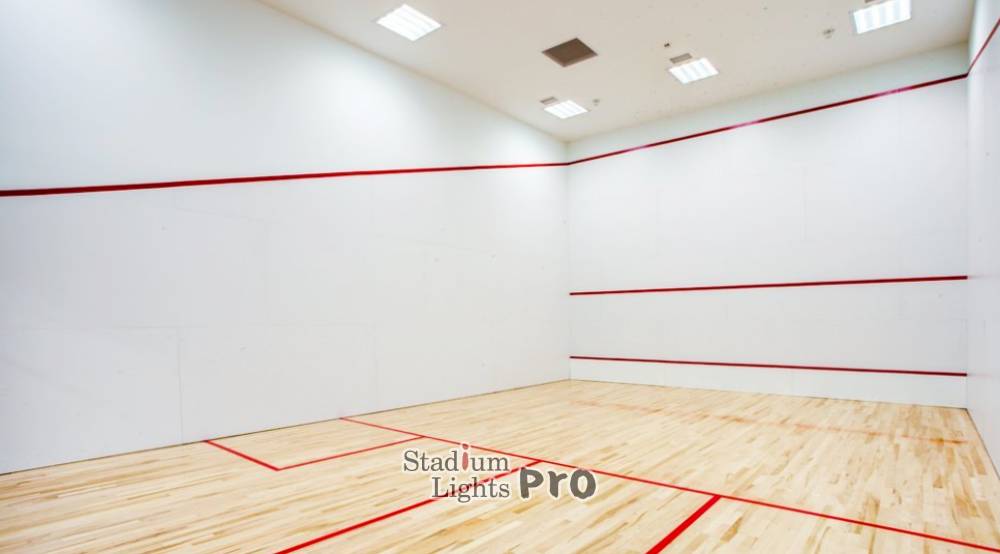
LED lighting has become the go-to choice for modern squash court illumination, and it’s not difficult to understand why. The evolution from traditional systems to LED has transformed how courts are lit—both in terms of performance and operational cost. LEDs offer an impressive lumen output per watt, delivering brighter light while consuming significantly less energy than older systems. This efficiency directly reduces utility bills and allows facilities to maintain high lighting standards without overextending their budgets.
But efficiency isn’t the only reason for LED’s dominance. LED fixtures provide instant start-up, meaning there’s no waiting period for lights to warm up—an issue that plagued older systems. Their dimmability and lower heat emission contribute to a more comfortable indoor playing environment, especially in tightly enclosed courts where temperature and air circulation are sensitive. Unlike legacy lighting, LEDs also offer a stable output over tens of thousands of hours, requiring minimal maintenance and ensuring that lighting remains consistent throughout its lifespan. This reliability makes them particularly suited for squash courts that host regular matches or extended training hours.
Outdated Systems and Their Challenges
Before LEDs became standard, metal halide and fluorescent fixtures were commonly used in squash courts. These systems delivered decent lighting levels when new, but their shortcomings became apparent over time. Metal halide lamps had long warm-up periods, sometimes taking 10 to 15 minutes to reach full brightness. This delay could interrupt match schedules or frustrate players and coaches during early-morning or after-dark sessions.
Fluorescent systems introduced their own set of limitations. While generally faster to light up, they tended to flicker, especially as they aged or when exposed to voltage fluctuations. This flickering isn’t just annoying—it can actively interfere with a player’s concentration and eye comfort. Moreover, both metal halide and fluorescent systems suffered from uneven degradation, meaning that even within a single court, light levels could become inconsistent over time. In contrast, modern LED systems maintain a uniform light output, avoiding these visual imbalances and offering a more consistent experience for players.
Fixture Design and Placement Styles
In addition to the technology inside the light source, how a fixture is designed and installed also affects performance. Surface-mounted fixtures are among the most popular choices for squash courts, primarily because they are easier to install and maintain. Their visibility makes it simpler to clean or replace them when needed. These fixtures are typically designed to be robust and shielded, reducing the risk of glare and accidental damage from ball impacts.
Recessed lighting offers a cleaner, more integrated look, especially in newer or renovated facilities. These fixtures are installed flush with the ceiling, reducing visual clutter and slightly improving aerodynamics within the court. However, recessed lights require a more complex ceiling design and might involve higher installation costs. For this reason, they are more often seen in high-end or professionally designed squash venues.
Regardless of whether the fixture is surface-mounted or recessed, most modern systems incorporate anti-glare shields or diffusers. These additions soften the light output and distribute it more evenly across the court, reducing the risk of hot spots or harsh reflections. Some fixtures are even equipped with adjustable beam angles, allowing designers to tailor the direction and focus of the light to match the court’s shape, size, and reflective properties. This adaptability helps eliminate blind zones and ensures smooth, full-court coverage.
Designing Lighting Layouts for Performance
Positioning to Avoid Shadows and Glare
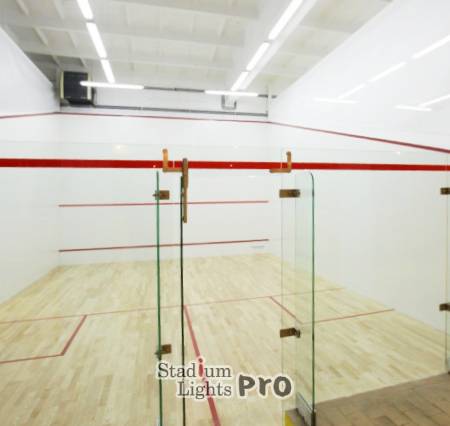 Shadows and glare are two of the most common problems in squash court lighting, and both can dramatically affect the quality of play. Shadows create areas of low visibility, interfering with a player’s depth perception and reaction time. Glare, on the other hand, can cause players to momentarily lose sight of the ball, especially during rapid exchanges when the ball is hit above eye level.
Shadows and glare are two of the most common problems in squash court lighting, and both can dramatically affect the quality of play. Shadows create areas of low visibility, interfering with a player’s depth perception and reaction time. Glare, on the other hand, can cause players to momentarily lose sight of the ball, especially during rapid exchanges when the ball is hit above eye level.
Lighting professionals work meticulously to avoid these issues by positioning fixtures so that they do not fall within a player’s direct line of sight. This means avoiding central ceiling placements or lights that reflect off shiny surfaces. Instead, fixtures are often placed around the perimeter of the ceiling, with beams angled inward. This design ensures that light reaches all corners of the court without creating direct glare or uneven patches. In courts with glass back walls or reflective features, care must also be taken to control reflections that might disorient players or create visual noise during a match.
Height and Beam Direction
The height at which fixtures are installed has a big influence on light distribution. Most squash courts install lighting between 5 to 6 meters above the floor, a height that allows beams to spread evenly without over-concentrating in one area. If lights are mounted too low, they can produce glare or harsh shadows. If placed too high, they may not provide adequate lux levels on the playing surface.
Another crucial factor is the direction and spread of the light beam. Some fixtures come with narrow-beam optics, which focus light on a more specific area. These are useful when a court has a lower ceiling or when accenting certain sections is needed. However, most courts benefit from wide-beam luminaires, which distribute light more broadly and produce a soft, diffused effect that minimizes harsh transitions between bright and dim areas. Choosing the right beam angle depends on the fixture’s mounting height, the total number of fixtures, and how reflective the walls and flooring are.
Reflectivity and Wall Surface Considerations
The color and finish of court surfaces play a surprising role in how effective the lighting system will be. Most squash courts use light-colored, matte-finish walls, which help reflect light while avoiding glare. These finishes diffuse the light, bouncing it softly across the playing area and maintaining a balanced visual field.
Highly reflective or glossy surfaces, while sometimes visually striking, can introduce unwanted glare or visual confusion, especially when a fast-moving ball reflects bright spots into a player’s line of sight. Wall texture and reflectivity must be considered in the early stages of lighting design, as they influence how much artificial light is needed and how it should be directed.
Even the floor matters. A dark, matte floor can absorb light and make the lower half of the court appear dimmer. Conversely, a highly reflective surface may bounce light upward in unpredictable ways. Balancing these surface interactions ensures a more cohesive and playable environment, where visibility remains consistent from the front wall to the back corner.
Tailoring the Number of Fixtures
There’s no one-size-fits-all approach when it comes to how many fixtures a squash court needs. Each court layout, ceiling height, and surface reflectivity must be assessed individually to determine the appropriate number and type of lights. A smaller training court might operate comfortably with four to six well-placed LED luminaires. However, larger or tournament-grade courts—especially those intended for televised events—may require eight to twelve fixtures to meet higher illuminance and uniformity standards.
The goal isn’t just to flood the space with light but to achieve the right lux levels with consistent distribution and minimal waste. Over-lighting a court can be just as problematic as under-lighting, leading to excessive energy use and possible glare issues. High-quality simulation software is often used in the planning stages to model the expected light distribution across every surface. This predictive modeling allows designers to make fine adjustments before installation, helping avoid costly rework and ensuring that every corner of the court is appropriately lit.
Installation and Maintenance Insights
Safe Wiring and Setup
Proper electrical design is a core part of installing squash court lighting. Cables must be securely routed and insulated, with appropriate circuit protection in place. In many cases, existing infrastructure can be reused during retrofitting, but licensed professionals should evaluate compatibility and load capacity.
Access and Serviceability
Since lighting fixtures are installed high above the court, maintenance access must be planned carefully. Modular LED fixtures with quick-release mounting systems make it easier to replace or clean units as needed. Minimizing fixture downtime is especially relevant in busy or tournament-focused facilities.
Keeping Lights Clean and Efficient
Dust and debris can reduce a luminaire’s output by up to 30% over time. Courts should implement a periodic cleaning schedule, focusing on lenses, diffusers, and reflective components. LEDs generate less heat and attract less dust than traditional lamps, making them easier to maintain over the long term.
Differences Between Indoor and Outdoor Squash Lighting
Outdoor Court Considerations
Outdoor squash courts, while less common than indoor setups, present a distinct set of lighting challenges. These open-air environments expose both players and infrastructure to the elements—rain, wind, humidity, and especially fluctuating sunlight. Because of these factors, lighting fixtures must be built to withstand weather extremes. A critical specification here is the Ingress Protection (IP) rating, which determines how well a fixture resists dust and water. For outdoor squash courts, fixtures rated IP65 or higher are typically required to prevent moisture intrusion and ensure long-term reliability.
In addition to water resistance, UV stability is another crucial factor. Fixtures installed outdoors must resist degradation from constant exposure to sunlight, which can cause housing materials to yellow, crack, or weaken over time. UV-resistant materials and coatings preserve the fixture’s structural integrity and optical performance, ensuring that lighting levels remain consistent over the years.
The playing experience itself is also influenced by the natural environment. Wind can affect ball trajectory, while shifting cloud cover or low sun angles can interfere with visibility. These variables make lighting consistency especially hard to achieve outdoors, which is why the design often leans heavily on smart lighting control and strategic placement of luminaires around the court’s perimeter.
Managing Natural Light and Timing
One of the most complex aspects of lighting an outdoor squash court is managing the influence of natural daylight. Morning matches may begin in dim or shadowy conditions, while late-afternoon games might suffer from blinding sun angles. Midday matches, though brightest, can introduce harsh shadows or uneven brightness that challenge visibility.
To address this, lighting control systems that respond to real-time ambient light levels are increasingly used. These systems use photocells or light sensors to detect current daylight intensity and automatically adjust the artificial lighting accordingly. This real-time dimming or brightening maintains a consistent visual environment regardless of time of day or shifting cloud cover.
Additionally, dynamic controls can be programmed to extend usability into twilight hours, gradually increasing brightness as natural light fades. This adaptability not only improves playability but also saves energy by ensuring lights are only at full brightness when needed. In combination with weather-resistant and UV-proof fixtures, such adaptive systems make outdoor squash lighting far more reliable and efficient than in the past.
Smart Controls and Automation in Court Lighting
Motion-Activated Systems
Energy efficiency is a growing concern for sports facilities, and squash courts are no exception. One of the simplest yet most effective tools for improving efficiency is the use of motion sensors. These sensors detect human presence and automatically control the lights, ensuring that courts are only illuminated when actively in use.
This type of system is particularly helpful in multi-court facilities, where usage patterns can be irregular. A squash court that remains empty for several hours doesn’t need to be lit continuously. Instead, lights can dim or turn off entirely until someone enters, instantly activating to full brightness when play begins. This approach not only cuts energy costs but also extends the lifespan of lighting equipment by reducing unnecessary runtime.
Timers and Pre-Set Schedules
For facilities that follow regular hours of operation, digital timers and programmable lighting schedules add another layer of efficiency and convenience. With these systems, lighting can be automatically turned on in anticipation of peak usage times and shut off after closing, eliminating the need for manual control by staff.
Pre-set schedules also help with planning around events, such as tournaments, training sessions, or maintenance. Lights can be programmed to run longer or shorter based on calendar needs, making energy usage more predictable and easier to manage. In larger complexes, this kind of scheduling supports load balancing, helping prevent energy spikes and minimizing utility costs during high-demand periods.
Daylight Harvesting and Dimming
In spaces where windows or skylights allow for partial access to natural light, more advanced control techniques like daylight harvesting can be implemented. This method uses light sensors to gauge the amount of daylight present and adjusts artificial lighting to fill in the gaps. When daylight is sufficient, artificial lights automatically dim, conserving electricity while maintaining a visually balanced environment.
This feature is particularly useful in hybrid designs or courts built with translucent ceilings or open sides, where ambient light may change frequently. Dimming capabilities also offer players and coaches a more customizable lighting environment, whether they want softer lighting for practice or full brightness for competitive play. These fine-tuned adjustments contribute to both energy conservation and athlete comfort.
Integration with Facility Management
In high-traffic sports centers or squash clubs with multiple courts, lighting systems are increasingly being tied into central facility management platforms. These platforms allow for remote monitoring and control, enabling staff to adjust settings, track energy use, and receive alerts if a fixture malfunctions—all from a single dashboard.
This integration streamlines operations, especially in facilities that juggle lighting, HVAC, security, and bookings all under one system. By consolidating these services into a unified interface, managers can optimize performance, reduce downtime, and make informed decisions based on real-time data. For squash courts, this means greater operational efficiency and better lighting reliability, which directly enhances player experience and customer satisfaction.
Closing Thoughts
Designing a lighting system for a squash court involves more than just brightness. It’s about delivering even illumination, managing glare, adapting to space constraints, and meeting performance standards that align with how the court is used. From fixture types to smart controls and layout planning, every detail contributes to the final playing environment. As facility managers and designers plan new installations or upgrades, focusing on these elements ensures that the lighting supports both the sport and those who love to play it.
